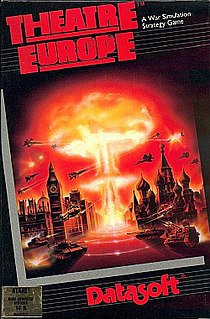
Theatre Europe is a turn-based strategy video game developed and published by Personal Software Services. It was first released in the United Kingdom for the Commodore 64, ZX Spectrum, Amstrad CPC and Atari 8-bit family home computers in 1985. It was later released in France by ERE Informatique in 1986, and was released in the United States by Datasoft later that year. A port for the Tatung Einstein was released in 1989, in the UK. It is the fifth installment of the Strategic Wargames series.
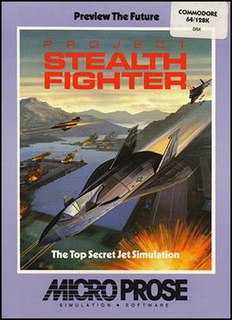
Project Stealth Fighter is a combat flight simulator released in 1987 by MicroProse, featuring a fictional United States military aircraft. During the time of the game's release there was heavy speculation surrounding a missing aircraft in the United States Air Force's numbering system, the F-19. Project Stealth Fighter was remade in 1988 for the 16-bit systems as F-19 Stealth Fighter with much improved graphics.

Ace of Aces is a combat flight simulation video game developed by Artech Digital Entertainment and published in 1986 by Accolade in North America and U.S. Gold in Europe. It was released for the Amstrad CPC, Atari 8-bit family, Atari 7800, Commodore 64, MSX, MS-DOS, Master System, and ZX Spectrum. Set in World War II, the player flies a RAF Mosquito long range fighter-bomber equipped with rockets, bombs and a cannon. Missions include destroying German fighter planes, bombers, V-1 flying bombs, U-boats, and trains. In 1988 Atari Corporation released a version on cartridge styled for the then-new Atari XEGS.

Wonder Boy is a 1986 platform game published by Sega and developed by Escape. Originally designed for arcades, it was later ported to the SG-1000, Mark III/Master System and Game Gear video game consoles by Sega, and to the ZX Spectrum, Commodore 64 and Amstrad CPC home computers by Activision. The game is also known as Super Wonder Boy for its Sega Mark III release in Japan and Revenge of Drancon for its Game Gear release in North America. A high definition remake of the game, titled Wonder Boy Returns, was developed by CFK and released on Steam on October 12, 2016.

Annals of Rome is a turn-based strategy video game developed by Level 9 Computing and published by Personal Software Services. It was first released in the United Kingdom for the ZX Spectrum, Amstrad CPC and Atari ST in 1986. It was then released in Germany for the Commodore 64 and Amiga in 1987 and 1988, respectively. The game is set in the late Roman Empire, with the objective being to survive for as long as possible against rebelling European states.

Battle of Britain is a turn-based strategy video game developed and published by Personal Software Services for the Commodore 64 in 1987. It was also ported to the Amstrad CPC and ZX Spectrum later that year. It is the seventh instalment to the Strategic Wargames series. The game is set during the Battle of Britain campaign of the Second World War and revolves around Britain's defence and prevention against a Nazi invasion. In the game, the player commands the Royal Air Force as they must defend key cities against the Luftwaffe.
Personal Software Services (PSS) was a British software company based in Coventry, founded by Gary Mays and Richard Cockayne in 1981. The company was acquired by Mirrorsoft in 1987. PSS produced video games for the ZX Spectrum, Commodore 64, Amiga, Atari ST, Atari 8-bit family, Amstrad CPC, Oric and IBM PC compatibles.

Wargame: European Escalation is a real-time tactics video game developed by Eugen Systems and published by Focus Home Interactive, released on February 23, 2012. It is set in Europe during the Cold War, most specifically in the years 1975–85 with alternate history scenarios portraying open war between NATO and the Warsaw Pact.
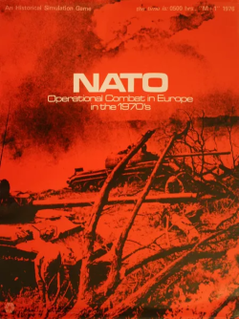
NATO: Operational Combat in Europe in the 1970s is a board wargame published by Simulations Publications Inc. (SPI) in 1973 that simulates an invasion of Western Europe by the Warsaw Pact.
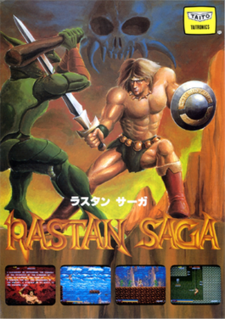
Rastan Saga, known as Rastan in North America, is a side-scrolling hack-and-slash action game originally released by Taito for arcades in 1987. The game was a critical and commercial success, and was ported to various home platforms.

Falklands '82 is a 1986 turn-based strategy video game developed and published by Personal Software Services for the ZX Spectrum and Commodore 64. It is the fifth instalment of the Strategic Wargames series. The game is set during the 1982 Falklands War and revolves around the Argentine occupation and subsequent British re-capture of the Falkland Islands. The player controls the British Task Force as they must either defeat all Argentine forces on the archipelago or re-capture every settlement.
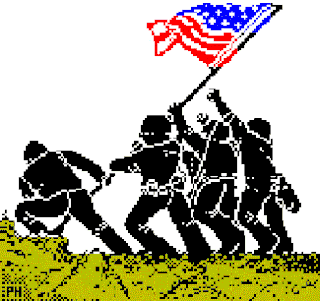
Iwo Jima is a turn-based strategy video game developed and published by Personal Software Services for the Commodore 64 and ZX Spectrum in 1986. It is the second instalment to the Strategic Wargames series. The game is set during the Battle of Iwo Jima in the Pacific Ocean theatre of World War II and revolves around the United States Marine Corps' objective to secure the island of Iwo Jima from the Imperial Japanese Army.

Bismarck is a turn-based strategy video game developed by Personal Software Services and published by Mirrorsoft. It was first released for the Commodore 64 and ZX Spectrum in 1987 for the United Kingdom. It was ported to Amiga, Apple II, Atari ST and Atari 8-bit home computers in both the United Kingdom and the United States the following year. The game is the tenth instalment in the Strategic Wargames series. In the game, the player can choose to control either the German battleship Bismarck or command the pursuing fleet of Royal Navy ships.

Tobruk: The Clash of Armour is a turn-based strategy video game developed by Data Design Systems and published by Personal Software Services. It was exclusively released in the United Kingdom for the Commodore 64, ZX Spectrum and Amstrad CPC in 1987. It is the eleventh instalment of the Strategic Wargames series. The game is set during the 1941 Siege of Tobruk of the Western Desert Campaign in World War II and revolves around the Allied forces attempts to overthrow German field marshal Erwin Rommel from the city.
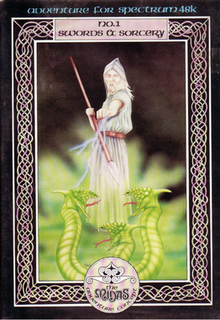
Swords and Sorcery is a fantasy role playing video game developed and published by Personal Software Services. It was released exclusively in the United Kingdom for the ZX Spectrum in 1985 and the Amstrad CPC in 1986. The game contains elements of dungeon crawling and revolves around a customisable player-character navigating through catacombs in order to secure a large wealth of treasure, whilst simultaneously collecting seven pieces of sacred armour.
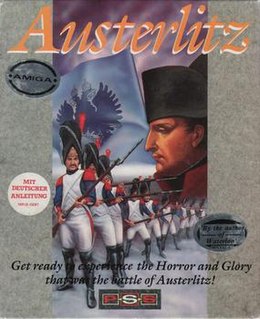
Austerlitz is a turn-based strategy video game developed by Personal Software Services and published by Mirrorsoft. It was released in the United Kingdom and Germany for the Amiga, Atari ST and MS-DOS home computers in 1989. It was also re-released in France for Amiga home computers by Mirror Image in 1991. The game is set during the Battle of Austerlitz of the Napoleonic Wars and revolves around Napoleon's forces defending the Austrian village of Austerlitz from the invading army of Alexander I of Russia.

The Battle For Midway is a turn-based strategy video game developed and published by Personal Software Services. It was first released in the United Kingdom and France for the MSX in 1984, and was re-released for the Amstrad CPC, Commodore 64 and ZX Spectrum in 1985. It is the second instalment of the Strategic Wargames series. The game is set during the Battle of Midway in the Pacific Ocean theatre of World War II and revolves around the United States Navy attacking a large Imperial Japanese fleet stationed at Midway Atoll, in retaliation for the attack on Pearl Harbor.

Pegasus Bridge is a turn-based strategy video game developed and published by Personal Software Services. It was released exclusively in the United Kingdom for the ZX Spectrum, Amstrad CPC and Commodore 64 in 1987. It is the ninth installment of the Strategic Wargames series. The game is set during the landings in Normandy on D-Day in the Second World War and revolves around the British 6th Airborne Division's attempts to secure a bridge over the Caen Canal.

Champion of the Raj is a turn-based strategy video game developed by Level 9 Computing and published by Personal Software Services. It was released exclusively in the United Kingdom for the Amiga, Atari ST, and IBM PC compatibles in 1991. It is the thirteenth and final instalment in the Strategic Wargames series. The game revolves around European imperialism and colonialism in India. Six factions–British, French, Mogul, Sikhs, Gurkhas, and Marathas–fight to gain overall control of India.

Judge Dredd is a platform shoot 'em up video game based on the character of the same name. It was developed by Beam Software and published by Melbourne House. It was released in Europe in 1986, for Commodore 64 and ZX Spectrum.




















